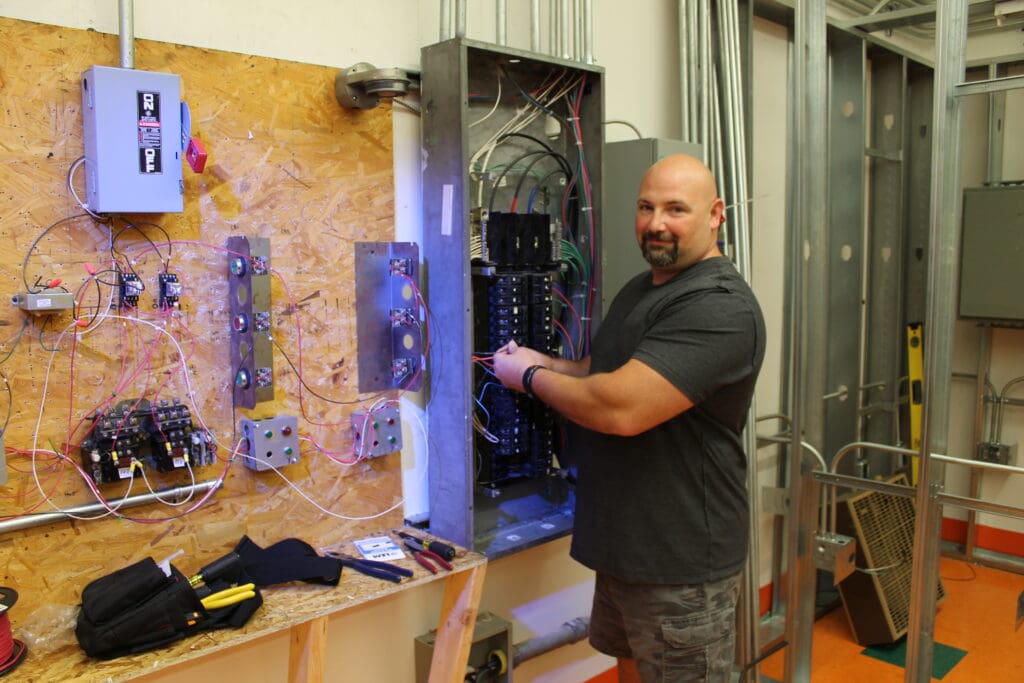Today’s society uses electricity for what seems like almost everything. We need electricity to keep our phones charged, our TVs on, our homes heated or cooled, and much more. Electricity is the common driving force behind most of our necessities. And for a lot of people, the influx of constant electricity can make it feel like an afterthought in our everyday lives. The history, purpose, and how electricity works are commonly taught during our years in school, but over time that information can fall by the wayside in our minds. If you’ve ever found yourself asking, “How does electricity work?” or simply need a refresher, we’re here to provide the answers.
What is Electricity?
Electricity, by definition, is a form of energy resulting from the existence of charged particles (such as electrons or protons), either statically as an accumulation of charge or dynamically as a current. Or in simpler terms, the flow of an electric charge.
Electricity is a naturally occurring phenomenon in nature and can take on a variety of forms. It’s also known as a secondary energy source because it can be converted from primary energy sources such as natural gas, nuclear energy, coal, wind energy, and solar energy.
A Brief History of Electricity
Since the 1600s, scientists and inventors have tried to understand the principles of electricity. Benjamin Franklin, Thomas Edison, and Nikola Tesla are major contributors to the field of electricity during those times.
Franklin was able to determine that lightning is electricity, Edison invented the first long-lasting incandescent light bulb, and Tesla brought alternating current electricity into play which reduced the costs of long-distance electricity flow. Tesla’s inventions specifically brought electricity into homes for indoor lighting and into factories to power industrial machinery.
Before electricity became an integral part of life, light was supplied by candles, whale oil, and kerosene lamps. Food was kept cold by ice boxes and wood or coal-burning stoves provided heat.
The Modern History of Electricity
Over time, the electricity demand has only increased. In 1936, President Franklin D. Roosevelt signed the Rural Electrification Act, which helped to bring electricity to rural areas that were far from existing distribution networks. This further helped develop the national power grid that is now broken up into three sections, the Western Interconnection, Eastern Interconnection, and the Texas Interconnection.
In the mid-to-late 1900s, solar and nuclear energy rose to prominence. Solar is a huge contributor to the renewable energy transition with the installation of solar panels that are commonly seen on rooftops. The first nuclear power station in the U.S. opened in 1958, and now there are 92 of them that deliver power to millions of homes.
Electronics are also a dominant piece of modern-day technology. After the first circuit board arrived in 1936, this technology would be used in electronics such as TVs, radios, and many others. Then came the computer chip, which could process more power on a smaller scale. Microchips are only getting more powerful as the years go by.

What is Electricity
How Does Electricity Get to You?
A key part of understanding how electricity works in our world is how that electricity gets to us for our various uses. The process of electricity delivery starts at a power plant. The power plant generates electricity and transmits and distributes it to power lines. Once electricity is transmitted and distributed to high-voltage power lines, electricity is then carried over long distances to provide electricity to homes and businesses.
The U.S. operates on three interconnected systems that deliver reliable service of electricity during times of peak demand. The Eastern Interconnection covers the area east of the Rocky Mountains and a portion of the Texas panhandle. The Western Interconnection covers the area from the Rocky Mountains to the west, and the Texas Interconnection covers most of Texas.
How Does Electricity Work?
Breaking down how electricity works requires looking at some of the smallest particles, known as electrons. When electrons are forced to move in sync, they end up causing friction, which leads to heat and then the creation of an electric charge. Electricity is the accumulation or movement of electrons and travels in a closed circuit for electrons to move through it.
When a circuit is closed, electricity then flows through electric wiring to power it through and bring power to such appliances or electronics. The opposite applies to an open circuit.
Now, let’s get into the nuts and bolts of electricity:
1. Atoms
Atoms make up everything in the world. At the heart of an atom is the nucleus, which contains protons and neutrons. The neutron has no electrical charge, but the proton has a positive electrical charge. Surrounding the nucleus are orbital shells that serve as a path for electrons. These electrons even travel at the speed of light.
The number of protons, neutrons, and electrons that an Atom is made of provides us information on which material it is and the unique combination at play. The material difference determines how many electrons are held onto. Some electrons may also be loosely bound, allowing them to float to other atoms.
2. Wires and Cables
Inside the slice of a copper cable, we would notice an amount of free range electrons of an atom bounce from one to another. This occurs completely at random in terms of direction. On the other hand, when you look into a slice of cable that was connected to a closed circuit, the voltage forces the electrons to move and flow in the same direction. The electrons, at this point, are trying to get back to the other terminal of the battery.
3. Volts and Voltage
Voltage is the pushing force of electrons in a circuit. The higher the voltage, the more the electrons can flow. This is similar to pressure in a water pipe. A volt is known as a Joule per Coulomb. Joules is a measurement of energy or work, and a coulomb is a group of flowing electrons. A 10V battery can provide 10 joules of energy.
4. AC/DC Power
And no, not the band. AC refers to the power, such as alternating current, and DC refers to a direct current. An alternating current is the flow going backwards and forwards in a circuit as the terminals are constantly reversed. An alternating current is the most common type of electrical power and is found in your home’s power sockets.
Direct currents are the current flow that goes directly in one direction, and no, not the boy band either. A direct current is provided from batteries and photovoltaic panels and is commonly used in portable electrical goods.
Power Up Your Career with Our Comprehensive Electrician Course
Empower your future with our comprehensive Electrician course. Enroll now and spark your career in the energy sector!
Start Your Career in Electronics
If you have an interest in electricity and electronics, starting your career at the Erie Institute of Technology is the first step forward. The Erie Institute of Technology offers an Electronics Technician Training program for those who either love working with the ins and outs of electronics or are looking to get started.
This program will help you learn the level of technical expertise needed to install, troubleshoot, and maintain electronic equipment. Visit the Erie Institute of Technology to start your career in electronics today.

Ross Aresco
CFO
Ross Aresco is the CFO of Erie Institute of Technology. Erie Institute of Technology (EIT) is an Erie Pennsylvania technical/trade school providing training programs for medical, computer, electronics, manufacturing, and technology careers. EIT offers programs in many different areas to suit your interests and talents.
